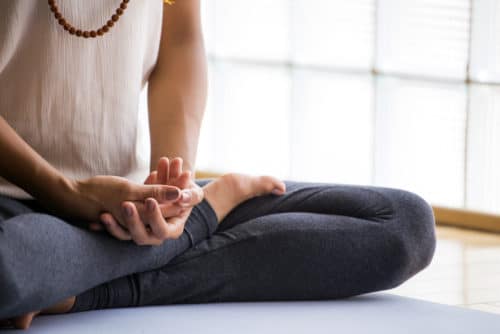 Try something with me.
Try something with me.
Take one moment. Breathe in through your nose and softly breathe out through your mouth. Close your eyes and allow yourself the space to bring all your attention to your breath. Slowly breathe in through your nose and out through your mouth. Focus your attention on the rising and falling of your stomach as you connect with your body. This is your time, your moment. The world is on pause and the only thing that matters is your breath.
Isn’t that nice? Doesn’t it feel good to take an authentic moment for yourself during your day? So, take another deep breath and I wish you luck on your journey as we learn about meditation for beginners.
What is meditation?
Meditation refers to a practice that centers on the integration of the mind and body. Commonly used to calm the mind, ground oneself, and enhance overall well-being, meditation can involve more than just zoning out and saying “Om”. It can utilize awareness of a particular sensation like a breath, a sound, or a mantra. Mindful-based meditation is another form of practice. Mindfulness is the practice of maintaining awareness of the present moment without judgments. This may look like noticing a thought that occurs during your practice and then letting it float away like a balloon. Meditation is not about clearing the mind and not thinking, because that would be impossible. The essence is allowing space. Allowing space for your thoughts to come and go freely without worry. It gives a special space of just being, opening, and accepting.
There are significant benefits of practicing this in our daily life. Meditation can clear stress and bring inner relaxation and peace. Meditation isn’t something that is conquered or mastered. It is a continuous practice of allowing our inner self space. Doesn’t that sound nice? No expectations or pressure, just practice. This practice can be set on goals like quieting inner chatter, deepening inner connection, or remaining present. There are many ways of holding this personal space and it is as unique as you are! It can be practiced at work, on walks, on busy days, at night, or whenever needed. Try to remain with yourself in being graceful with the practice and attempting new ways of harnessing this inner serenity.
Meditation for beginners
Guided meditations are a great way to start and practice meditation. A guided meditation will usually have someone speaking in a soft tone that will help lead and guide you. Most important is making the conscious decision to take time for yourself, knowing this is only for you. It is something to give back to yourself. Make sure to choose a space that feels safe, comfortable, quiet, and free of distractions. Silence the TV or phone so that you can hold this space for yourself. Everything you need to do will be waiting for you once you take this time. And remember you are practicing. This means starting slowly. Don’t rush or pressure yourself. Again, this is a practice, a journey. Now try taking one minute to repeat the small exercise at the beginning.
Now that we have a better understanding of meditation and mindfulness, here are some helpful tips.
 Listen to yourself
Listen to yourself
Try to be aware of stressful times of the day or anxious moments. These are great times to try to incorporate the practice. It will bring relief in knowing you have taken a moment for yourself before taking on the day. This can also be applied to sleeping as well. Knowing you have taken the moment to release the day’s stresses.-Be comfortable: There are many ways to feel comfortable. This may entail sitting or lying down, eyes open or closed, breathing out loud or softly, or bringing your hands to your stomach, heart, or palms up to invite an opening feeling.
Please don’t push it
Bring your focus to yourself. Breathe slowly and naturally. Allow your body to take the space it needs. Don’t force yourself into a state that is uncomfortable. This is key! If the space feels good for 5 minutes, then allow yourself to fully enjoy the moment as it works for you.
Acknowledge fleeting or intrusive thoughts and emotions
Sitting in this space may bring wandering thoughts or emotions. This is okay. We have a lot going on in our life so it would make sense that this time would also incorporate these aspects. Remember the goal is not clearing your mind but is about holding a non-judgmental space in which we can be aware. Use your breath as a guide and always bring it back to that sensation. If you notice strong emotions manifesting, then allow yourself the time to sit in that. There are no right ways. There is just a moment for us. Congratulations! You’ve taken the first steps in meditation for beginners.
Contact us today to schedule a complimentary 15-minute phone consultation or to book an appointment.
My therapeutic style is warm, non-judgmental, and supportive so that you may express yourself openly and freely. I work with clients struggling with anxiety, stress from daily life, depression, and difficulties within relationships. My approach is warm, compassionate, respectful, and culturally sensitive. I believe all people are unique, experiential, and creative in their own thoughts and feelings.

